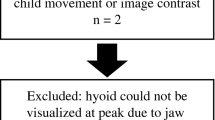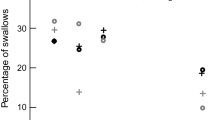Abstract
Preterm infants often have dysphagia. Because reducing lifetime cumulative exposure to radiation in the context of diagnosis and treatment is a continuing goal of all medical fields which use X-ray imaging, efforts exist to reduce reliance on the gold standard diagnostic tool for dysphagia, VFSS. Alternatives, such as video of external hyolaryngeal movement using video recordings of the anterior surface of the neck, must be evaluated and validated against videofluoroscopy, a task for which non-human animal models are appropriate. In this study, we tested the hypotheses that (1) swallows could be identified equally well from video of external hyolaryngeal movement and bolus movement in videofluoroscopy, and that (2) the two measures would be tightly temporally linked in both term and preterm infant pigs. We recorded 222 swallows in simultaneous and precisely synchronized high-speed videofluoroscopy and high-speed camera films of 4 preterm and 3 term infant pigs drinking milk from a bottle. In term pigs, the two measures consistently identified the same swallows in each image stream. However, in preterm pigs there was a high rate of false positives (~ 10% per feeding sequence) and false negatives (~ 27% per feeding sequence). The timing of hyolaryngeal elevation (external video) and bolus movement (videofluoroscopy) was correlated and consistent in terms pigs, but not in preterm pigs. Magnitude of hyolaryngeal elevation was less in preterm pig swallows than term pig swallows. Absence of epiglottal inversion in preterm pigs was not linked to variation in the timing of the two swallow events. Video of external hyolaryngeal movement, though a reliable swallow indicator in term infant pigs, was unreliable in preterm infant pigs. The coordination of swallowing events differs in preterm and term infant pigs. More research is needed into the distinctive biomechanics of preterm infant pigs.




Similar content being viewed by others
References
Logemann JA. Role of the modified barium swallow in management of patients with dysphagia. Otolaryngol Neck Surg. 1997;116:335–8.
Lefton-Greif MA, Arvedson JC. Pediatric feeding and swallowing disorders: state of health, population trends, and application of the international classification of functioning, disability, and health. Semin Speech Lang. 2007;28:161–5.
Molfenter SM, Steele CM. Physiological variability in the deglutition literature: hyoid and laryngeal kinematics. Dysphagia. 2011;26:67–74.
Gross A, Ohlemacher J, German R, Gould F. LVC timing in infant pig swallowing and the effect of safe swallowing. Dysphagia. 2018;33:51–62.
Riley A, Miles A, Steele CM. An exploratory study of hyoid visibility, position, and swallowing-related displacement in a pediatric population. Dysphagia. 2019;34:248–56.
Gewolb IH, Vice FL, Schweitzer-Kenney EL, Taciak VL, Bosma JF. Developmental patterns of rhythmic suck and swallow in preterm infants. Dev Med Child Neurol. 2001;43:22–7.
McGrattan KE, Sivalingam M, Hasenstab KA, Wei L, Jadcherla SR. The physiologic coupling of sucking and swallowing coordination provides a unique process for neonatal survival. Acta Paediatr. 2016;105(7):790–7.
Goldfield EC, Smith V, Buonomo C, Perez J, Larson K. Preterm infant swallowing of thin and nectar-thick liquids: changes in lingual-palatal coordination and relation to bolus transit. Dysphagia. 2013;28:234–44.
Crompton AW, German RZ, Thexton AJ. Development of the movement of the epiglottis in infant and juvenile pigs. Zoology. 2008;111:339–49.
CASPLO. Practice standards and guidelines for dysphagia interventions by speech language pathologists. Toronto: CASPLO; 2018.
Rappazzo CA, Turk CL. The videofluoroscopic swallow study: introduction, limitations, and challenges. In: Ongkasuwan J, Chiou EH, editors. Pediatric dysphagia—challenges and controversies [Internet]. Cham: Springer; 2018. p. 67–86.
Henderson M, Miles A, Holgate V, Peryman S, Allen J. Application and verification of quantitative objective videofluoroscopic swallowing measures in a pediatric population with dysphagia. J Pediatr. 2016;178(200–205):e1.
Goldfield EC, Buonomo C, Fletcher K, Perez J, Margetts S, Hansen A, et al. Premature infant swallowing: patterns of tongue-soft palate coordination based upon videofluoroscopy. Infant Behav Dev. 2010;33:209–18.
Gewolb IH, Vice FL. Maturational changes in the rhythms, patterning, and coordination of respiration and swallow during feeding in preterm and term infants. Dev Med Child Neurol. 2006;48:589–94.
German RZ, Crompton AW, Gould FDH, Thexton AJ. Animal models for dysphagia studies: what have we learnt so far. Dysphagia. 2017;32(1):73–7.
Ballester A, Gould F, Bond L, Stricklen B, Ohlemacher J, Gross A, et al. Maturation of the coordination between respiration and deglutition with and without recurrent laryngeal nerve lesion in an animal model. Dysphagia. 2018;33:627–35.
German RZ, Crompton AW, McCluskey C, Thexton AJ. Coordination between respiration and deglutition in a preterm infant mammal, Sus scrofa. Arch Oral Biol. 1996;41:619–22.
Sangild PT, Thymann T, Schmidt M, Stoll B, Burrin DG, Buddington RK. Invited review: the preterm pig as a model in pediatric gastroenterology. J Anim Sci. 2013;91:4713–29.
Gould FDH, Lammers AR, Ohlemacher J, Ballester A, Fraley L, Gross A, et al. The physiologic impact of unilateral recurrent laryngeal nerve (RLN) lesion on infant oropharyngeal and esophageal performance. Dysphagia. 2015;30:714–22.
Gould FDH, Ohlemacher J, Lammers AR, Gross A, Ballester A, Fraley L, et al. Central nervous system integration of sensorimotor signals in oral and pharyngeal structures: oropharyngeal kinematics response to recurrent laryngeal nerve lesion. J Appl Physiol. 2016;120:495–502.
Holman SD, Campbell-Malone R, Ding P, Gierbolini-Norat EM, Lukasik SL, Waranch DR, et al. Swallowing kinematics and airway protection after palatal local anesthesia in infant pigs: swallowing after palatal anesthesia. Laryngoscope. 2014;124:436–45.
German RZ, Campbell-Malone R, Crompton AW, Ding P, Holman S, Konow N, et al. The concept of hyoid posture. Dysphagia. 2011;26:97.
Gould FDH, Yglesias B, Ohlemacher J, German RZ. Pre-pharyngeal swallow effects of recurrent laryngeal nerve lesion on bolus shape and airway protection in an infant pig model. Dysphagia. 2016. https://doi.org/10.1007/s00455-016-9762-2.
Amaizu N, Shulman RJ, Schanler RJ, Lau C. Maturation of oral feeding skills in preterm infants. Acta Paediatr. 2008;97:61–7.
Barlow SM, Lee J, Wang J, Oder A, Hall S, Knox K, et al. Frequency-modulated orocutaneous stimulation promotes non-nutritive suck development in preterm infants with respiratory distress syndrome or chronic lung disease. J Perinatol. 2014;34:136.
DeLozier KR, Gould FDH, Ohlemacher J, Thexton AJ, German RZ. The impact of recurrent laryngeal nerve lesion on oropharyngeal muscle activity and sensorimotor integration in an infant pig model. J Appl Physiol. 2018;125:159–66.
Funding
Grant support: NIH R01 HD088561 was provided to Rebecca German.
Author information
Authors and Affiliations
Corresponding author
Additional information
Publisher's Note
Springer Nature remains neutral with regard to jurisdictional claims in published maps and institutional affiliations.
Electronic supplementary material
Below is the link to the electronic supplementary material.
Rights and permissions
About this article
Cite this article
Catchpole, E., Bond, L., German, R. et al. Reduced Coordination of Hyolaryngeal Elevation and Bolus Movement in a Pig Model of Preterm Infant Swallowing. Dysphagia 35, 334–342 (2020). https://doi.org/10.1007/s00455-019-10033-w
Received:
Revised:
Accepted:
Published:
Issue Date:
DOI: https://doi.org/10.1007/s00455-019-10033-w




